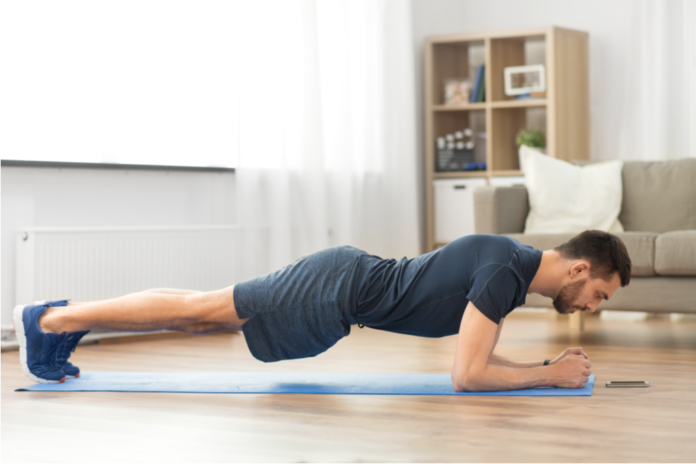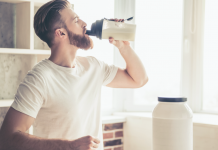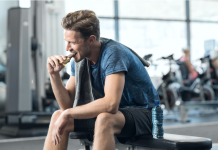Are core strengthening exercises really that important? Most health professionals would agree so.
Often neglected in fitness routines, core strength is vital and is many peoples’ limiting factor when it comes to enhancing performance and daily activities of life. The benefits of a strong core are endless, so it is time to prioritize focusing on them.
Ahead, learn all about why it is important to have a strong core and just how to build a strong core to improve fitness and overall strength.
What Is the Core?
The core is frequently synonymous with abdominal muscles, but they actually differ. The abdominals are part of the core, which also includes muscles, tendons, and ligaments that help move the hips and back. In the sports world, it’s referred to as the lumbar-pelvic and hip complex and is composed of nearly 35 different muscle groups.
The core is the center of gravity where all skeletal movement begins and is the center of stability for the lower limbs, functioning as a stabilizer and mobilizing bone to allow for movement. The body’s stabilization system needs to function optimally in order to effectively utilize the strength, power, and muscular endurance of other muscle groups, especially the legs.
What Makes Up the Core?
Although the core technically involves over 35 muscle groups, the most prominent ones include:
- Rectus abdominis: the quintessential six-pack that extends from the ribs to the pubic bone
- External oblique muscles: located on the lateral sides of the torso
- Internal oblique muscles: lie beneath the external obliques (not visible to the eye)
- Transverse abdominis: a deep muscle that wraps around the spine and abdominal organs and plays a protective and supportive role
- Glute muscles (maximus, medius, and minimus): responsible for the majority of strength and power in the lower body; contribute to stability and balance; move legs away from the body via hip abduction
- Hip adductors: support alignment, balance, and stability and move legs inward
- Latissimus Dorsi: run the length of the back from below the shoulder blades to the hip bones and is responsible for the common pull-up
- Erector spinae: include the three muscles that lie vertically (iliocostalis, longissimus, spinalis) on both sides of the spine
- Pelvic floor muscles: collection of small muscle tissue that supports the bladder, bowel, and reproductive organs
Also noteworthy, visible abs don’t necessarily equate to a strong core. Obvious abdominal muscles simply indicate someone has a low body fat percentage. Conversely, someone can carry extra weight but still have an exceptionally strong core.
Benefits of a Strong Core
Most include ab exercises in hopes to build a 6 pack, though proper core workouts can lead to major benefits.
1. Prevent Pain & Injuries
The core can be pictured as a sturdy cylinder surrounding the spine and important organs. A developed core allows one to activate and engage that cylinder when using other muscles or performing everyday tasks. Thus, the stronger the core, the less likely one is to injure other muscles with improper form.
Research shows that strong cores reduce back and hip pain as well, although even more so for the former. This is because muscle groups typically oppose each other, meaning one is the agonist while the other is the antagonist. Imbalances in any muscle group increase the risk of injury. The major core antagonist is the back and vice versa, so it makes sense that the stronger the core, the less likely the back is to get injured.
Core strength also helps prevent spine injuries and pain. The core musculature keeps the spine in a safe, neutral position while stationary and during movement, preventing over-flexing, extending, and rotating, which frequently lead to injuries.
2. Improves Athletic Performance
Because the core is partially responsible for many movements, allowing the body to bend, twist, flex, extend, step, jump, sit up and stand, it is important that it’s strong and sturdy. The stronger the core the easier it is to control movements, which can lead to enhanced performance.
This benefit isn’t limited to only strength exercises like the deadlift, squat, overhead press, etc. Rather, a strong core also makes any movement requiring forceful power like running, biking, swimming, and more.
3. Boosts Balance & Stability
As already mentioned, the core is primarily responsible for the balance and stability of all muscles and bones. Weak cores promote weak movements, while strong cores bolster powerful, controlled, and forceful movements. This is not only important for athletic endeavors but in everyday life as well.
Everything from sitting in a chair to carrying groceries becomes easier and more efficient with strong core muscles.
4. Promotes Good Posture
Although rarely discussed, good posture is important for optimal health. Posture refers to the positioning of the body while sitting, standing, or lying down and is the result of formed habits. Therefore, good posture refers to properly aligning the spine and body and involves training the body to withstand gravity with the least amount of strain and tension on supporting structures such as muscles and ligaments.
In turn, posture creates a domino effect, influencing everything from muscle and joint range of motion, back and neck pain, digestion, spine health, mood, and more. If strengthening the core helps achieve all of this, it’s a wonder more people don’t consistently include it in their fitness routines.
5. Enhances Quality of Life
A culmination of the above points, a strong core really can improve one’s quality of life. Decreased pain, fewer injuries, improved athletic performance, and being able to do activities of daily living with greater ease cascade to offer boosted energy, greater ability to adventure, more independence and so much more.
Furthermore, a strong core increases the viable number of recreational activities, allows one to complete tougher or more strenuous physical endeavors, promotes being able to play with children well into adulthood, tackle home projects without throwing out a back – the list goes on.
Just like the core is the center of the body, it is also central to thriving in life.
How to Build a Strong Core
So the benefits of a strong core are hopefully evident by now, but how exactly can one build said core?
Well, it involves more than doing typical ab movements like crunches, bicycles, or leg lifts. As alluded to earlier, developing a strong core engages multiple muscle groups and contracts the front and back at the same time.
Many of the most promising exercises are compound or multi-jointed. Often, these core strengthening movements involve stability balls, medicine balls, BOSU balls, and balance boards and can be executed at a gym or the home.
Maybe surprising, but there is actually little research that delineates the best core exercises. Rather, it seems that other factors such as mind-muscle connection, variety of movements, and frequency and length of movements matter more. Basically, this means that taking the time to execute proper form and focusing on really engaging the muscles at work are as important, if not more so, than specific exercises.
Also worth noting, specific styles of exercise inherently utilize and strengthen the core such as yoga, pilates, barre, and running.
Nonetheless, below lists some best exercises to build a durable core and just how to execute them!
Plank
Begin in a plank position, face down with forearms and toes on the floor. Elbows should be directly underneath the shoulders, back should be parallel to the floor, forearms facing forward, and head relaxed. Engage the abdominals by squeezing the belly button to the spine, keeping the torso straight and parallel to the floor.
Hold this position for 20-120 seconds and increase the difficulty by moving side to side, lifting one leg and/or one arm, or touching hands to the opposite shoulder.
V-Sit
Start by laying on the back on the ground. Contract/engage the abdominal muscles and lift legs to a 45-degree extended position. At the same time, reach arms forward or towards as far up the shins as possible, keeping shoulders back, chest open, and breathing while holding.
Stay in this position for 1-10 seconds and then return almost to the beginning position, but keep shoulders and feet slightly lifted to continue engaging the core. Repeat 8-15 times for 2-4 sets.
Oblique/Russian Twist
Sit on the floor with knees bent and feet flat on the floor for an easier rendition or slightly raised for a harder version. Contract the abdomen and remain sitting at a 45-degree angle. Hold a weight such as a dumbbell or medicine ball (or nothing) directly in front of you, then twist to one side of the body and touch the weight to the floor, holding for a moment before repeating on the other side.
Perform a total of 10-15 reps on each side for 2-4 sets.
Back/Glute Bridge
Lie on the back with hands at the sides, knees bent, and feet flat on the floor directly under the knees. Tighten the abdominal and glute muscles by pushing the lower back into the ground before pushing up into the bridge by raising the hips to create a straight line from the knees to the shoulders. Squeeze the core and visualize pulling the belly button back towards the spine.
Hold the static position for 20-60 seconds for 2-4 sets or execute a dynamic version for 10-15 reps.
Lunge with Twist
Stand with feet shoulder-width apart. Feel free to hold a weight like a dumbbell or medicine ball in front of you with arms bent at 90 degrees. Step forward into a lunge position with one foot. Hold this position, keeping the knee directly over the foot, and twist the upper body to the same side, engaging the midsection and squeezing the glutes. Push off the ground with the front, lunged leg, and return to starting position.
Perform 8-15 reps on each leg for 2-4 sets.
The Takeaway
Developing a strong core is a vital part of life. It’s helpful for athletic performance, balance, and stability, but it can also truly enhance the quality of one’s life.
Although often neglected, it should comprise a large part of one’s fitness routine as it comprises many major muscle groups well beyond the abdominals. In turn, this affects nearly every aspect of life from sitting in a certain posture to lifting heavy household objects to keeping up with active kiddos.
Start training the core today with a few of the exercises above and feel the difference of a transformed core.
References:
Barrington Orthopedic Specialists. The Importance of Posture. Barrington Orthopedic Specialists. Published June 9, 2020. www.barringtonortho.com/blog/the-importance-of-posture.
Capritto A. Why You Really Need a Strong Core, for Fitness and Life. CNET. Published November 24, 2020. www.cnet.com/health/fitness/why-you-really-need-a-strong-core-for-fitness-and-life/.
Donatelli R. What Is The Core? Sports Injuries, Treatment and Performance Information. Published June 29, 2019. www.sportsmd.com/performance/core/.
Quinn E. Don’t Waste Your Time With Ab Crunches-Try These Core Burners. Verywell Fit. Published June 2, 2020. www.verywellfit.com/the-best-exercises-for-core-strength-3120054.









